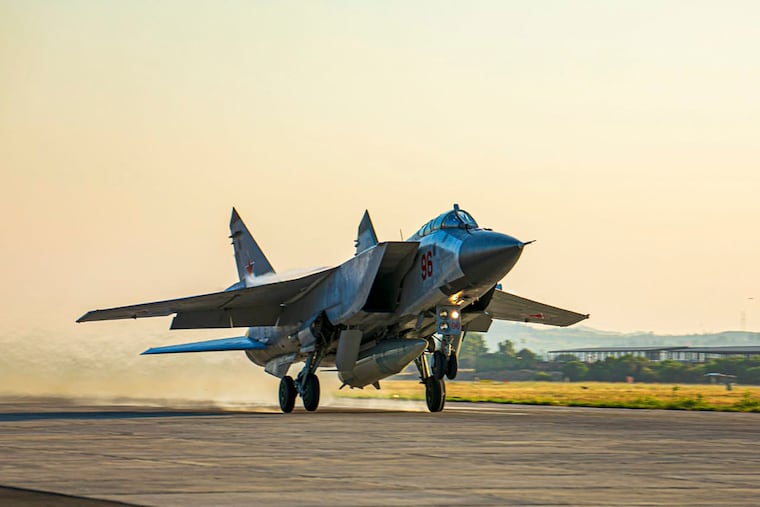What to know about hypersonic missiles, which Russia says it has used against Ukraine
These missiles travel faster than five times the speed of sound and have not been used before in combat.

Russia says it is using hypersonic missiles against Ukraine — a claim that President Joe Biden confirmed Monday at the Business Roundtable’s CEO Quarterly Meeting. Such missiles travel faster than five times the speed of sound and have not been used before in combat.
A spokesman for the Russian Defense Ministry said Saturday that Russia had used a Kinzhal, or "dagger," hypersonic missile late last week to destroy an ammunition depot in western Ukraine.
On Sunday, the Kremlin said its forces had launched hypersonic missiles a second time, this time from the airspace over Crimea, destroying a fuel storage facility in Ukraine's Mykolaiv region, according to a statement from the Russian Defense Ministry.
Arms specialists and the U.S. and U.K. governments have downplayed Russia's hypersonic abilities — and the degree to which their use on the battlefield matters.
What are these missiles? And what would it mean if Russia was using them? Here's what to know.
What are hypersonic missiles?
Hypersonic weapons fly at least at Mach 5 — five times the speed of sound.
There are two main types: hypersonic cruise missiles, which are powered by scramjets — high-speed engines; and hypersonic gliding vehicles, which are launched from a rocket but glide into their target.
» READ MORE: Ukraine retakes a key Kyiv suburb from Russia as the battle for Mariupol rages
The Kinzhal, an air-launched ballistic missile that can be maneuvered, is a modified version of Russia's Iskander missile. "The Iskander missile has already been used in the [Russia-Ukraine] conflict a number of times, but it's ground-launched. It's very similar," said Tom Karako, senior fellow at the Center for Strategic and International Studies, a Washington think thank, and director of the Missile Defense Project.
Karako, who cowrote a report titled "Complex Air Defense: Countering the Hypersonic Missile Threat," said other types of missiles reenter the atmosphere at hypersonic speeds. What people mean when they say hypersonic is a weapon "that is capable of sustaining hypersonic speeds for a long time," he said.
The Iskander and Kinzhal missiles can follow low trajectories and are maneuverable.
That makes it harder to figure out where the missile is going, what the intended target is and what the trajectory is — which "complicates the defense job," he said.
What distinguishes the Kinzhal hypersonic missile?
According to claims reported in the Russian media, the Kinzhal can reach Mach 10. Russia test-fired the weapon in July 2018, launched from a modified MiG-31 fighter, according to U.S. intelligence quoted in a Congressional Research Service report released March 17. It reached a target at a distance of about 500 miles.
The CRS report states that the Kinzhal could eventually be equipped with a nuclear warhead, and is capable of striking ground and naval targets, though it warned that the weapon's performance characteristics have not been verified by U.S. intelligence and that analysts are skeptical. The missiles are intended to evade sophisticated defenses.
Putin unveiled the Kinzhal during a nationally televised address before Russia's 2018 presidential election.
» READ MORE: In visit, Biden will thank Polish leader for refugee efforts
At the time, the Pentagon downplayed Putin's speech, saying U.S. assessments had already factored in Russia's weapon capabilities, according to the Guardian.
"It's a huge misperception to think that these things cannot be defeated, cannot be defended against," Karako said. "At the end of the day, they're just missiles."
Which countries have hypersonic missiles?
Russia, China and the United States have the most advanced hypersonic weapons programs, but other countries including Japan, Germany, India and Australia are also developing them, according to the CRS report.
Russia has been pursuing hypersonic weapons since the 1980s, but it has accelerated its efforts in response to the U.S. withdrawal from the Anti-Ballistic Missile Treaty in 2002 and the U.S. defense missile deployments in U.S. territory and Europe, the CRS report states. Aside from the Kinzhal, Russia is working on two other hypersonic weapons programs: the 3M22 Tsirkon (or Zircon) and the Avangard.
The United States has been conducting research on hypersonic weapons since the early 2000s and is developing them under the Navy’s Conventional Prompt Strike program as well as other programs that fall under the Air Force, the Defense Advanced Research Projects Agency and the Army.